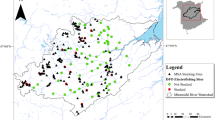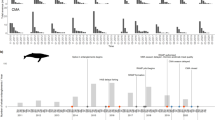Abstract
Northwestern United States' salmon populations have fallen precipitously. Attempts at salmon restoration are going on and dam breaching is being considered. Costs associated with the continued restoration attempts including hatchery stocking, barging and trucking salmon around the dams are high while benefits are unclear. Those costs may be greater than dam breaching. An additional impetus for dam removal is the revival of the commercial salmon fishing industry. This may not occur for both ecological and economic reasons. Ecologically complete restoration may not be feasible. Economically, the rise of competitively priced salmon aquaculture will reduce the value of any future commercial catch. A statistical relationship between falling prices for wild salmon and rising salmon aquaculture output is shown.
Similar content being viewed by others

References
Blumm, M.C.,Lucas, L.J.,Miller, D.B.,Rohlf, D.J. andSpain, G.H.: 1998, 'Saving Snake River water and salmon simultaneously: the biological, economic, and legal case for breaching the Snake River dams, lowering John Day reservoir, and restoring natural river flows', Environmental Law 28(4), 997-1058.
Brenninkmeyer, M.L.: 1999, 'The ones that got away: regulating escaped fish and other pollutants from salmon fish Farms', Boston College Environmental Affairs Law Review 27(1), 75-122.
U.S. Fish and Wildlife Service: March 20, 2001, 'The Endangered Species Act of 1973', http://endangered.fws.gov/esa.html.
ECONorthwest: 1999, 'Salmon and the Economy', November, under a grant from Center for Watershed and Community Health, http://www.ems.org/saving salmon/econorthwest.pdf.
Fisheries and Oceans Canada: 1999, 'Canada and U.S. reach a comprehensive agreement under the Pacific salmon treaty', June 3, http://www.dfo-mpo.gc.ca/COMMUNIC/NEWSREL/1999/hq29e.htm.
Fletcher, G.,Goddard, S. andWu, Y.: 1999, 'Antifreeze proteins and their genes: From basic research to business opportunity', CHEMTECH, 30(6), 17-28.
Goodstein, E.: 1998, 'Dam economics: overview and application to the lower Snake River', February, unpublished ms., Lewis and Clark College.
Huppert, D.D.: 1999, 'Snake River salmon recovery: quantifying the costs', Contemporary Economic Policy 17(4), October, 476-491.
Independent Economic Analysis Board: 1999, 'River economics evaluating trade-offs in Columbia river basin fish and wildlife programs policies', February 2, Northwest Power Planning Council.
Lansing, P. andVogel, E.: 1998, 'Restoring the lower Snake River: saving Snake River salmon and saving money', Oregon Natural Resources Council Fund.
Northwest Power Planning Council Workshop on Fish and Wildlife Governance: 1996, February 1-2, Portland, Oregon, http://www.newsdata.com/enernet/fishletter/documents/fl1doc3.html.
Pindyck, R. andRubinfeld, D.: 1981, Econometric Models and EconomicForecasts, McGraw-Hill, NewYork.
Safina, C.: 1998, Song for the Blue Ocean, Henry Holt and Company, New York.
Seafood Price Current, 1981-1999, Urner-Barry, Inc., courtesy of Gunnar Knapp, Professor of Economics, Institute of Social and Economic Research University of Alaska Anchorage.
Ludwig, D.,Hilborn R. andWaters C.: 1993, 'Uncertainty, resource exploitation, and conservation: lessons from history', Science 260(5104), 17-18.
Robinson, J.: 1996, 'The role of nonuse values in natural resource damages: past, present, and future', Texas Law Review 75, 189.
Marvin Shaffer & Associates Ltd., andI.A.S. International Analytic Science Ltd.: 1999, 'Pacific Northwest Salmon Recovery Efforts and the Pacific Salmon Treaty', Prepared For The Departments Of Fisheries & Oceans And Foreign Affairs and International Trade Of The Government Of Canada, http://www.ncr.dfo.ca/communic/Reports/shaffee.htm.
U.S. DOE: 1995, Columbia River System Operation Review: Final EIS, and Appendices, U.S. DOE: Portland, Oregon.
Verhovek and Howe, S.: 1999, 'Returning river to salmon, and man to the drawing board', The New York Times, 1999.
Washington Department of Fish and Wildlife andOregon Department of Fish and Wildlife: 1999, Status Report: Columbia River Fish Runs and Fisheries 1938-1998, November.
White, R.,Karr, J. andNehlsen W.: 1995, 'Better roles for fish stocking in aquatic resource management', American Fisheries Society Symposium 15, 527-547.
Whittlesey, N.,Butcher, W. andMarts, M.: 1995, 'Water project subsidies: how they develop and grow', illahee 11(1-2), 77-86.
Wiley, R.W.,Whaley, R.A.,Satake, J.A. andFowden, M.: 1993, 'Assessment of stocking hatchery trout: a wyoming perspective', North American Journal of Fisheries Management 13, 160-170.
Author information
Authors and Affiliations
Rights and permissions
About this article
Cite this article
Tucker, M. The Northwest U.S. Dam Breaching Decision: Factors, Costs and Benefits. Environment, Development and Sustainability 3, 217–227 (2001). https://doi.org/10.1023/A:1012736425264
Issue Date:
DOI: https://doi.org/10.1023/A:1012736425264



